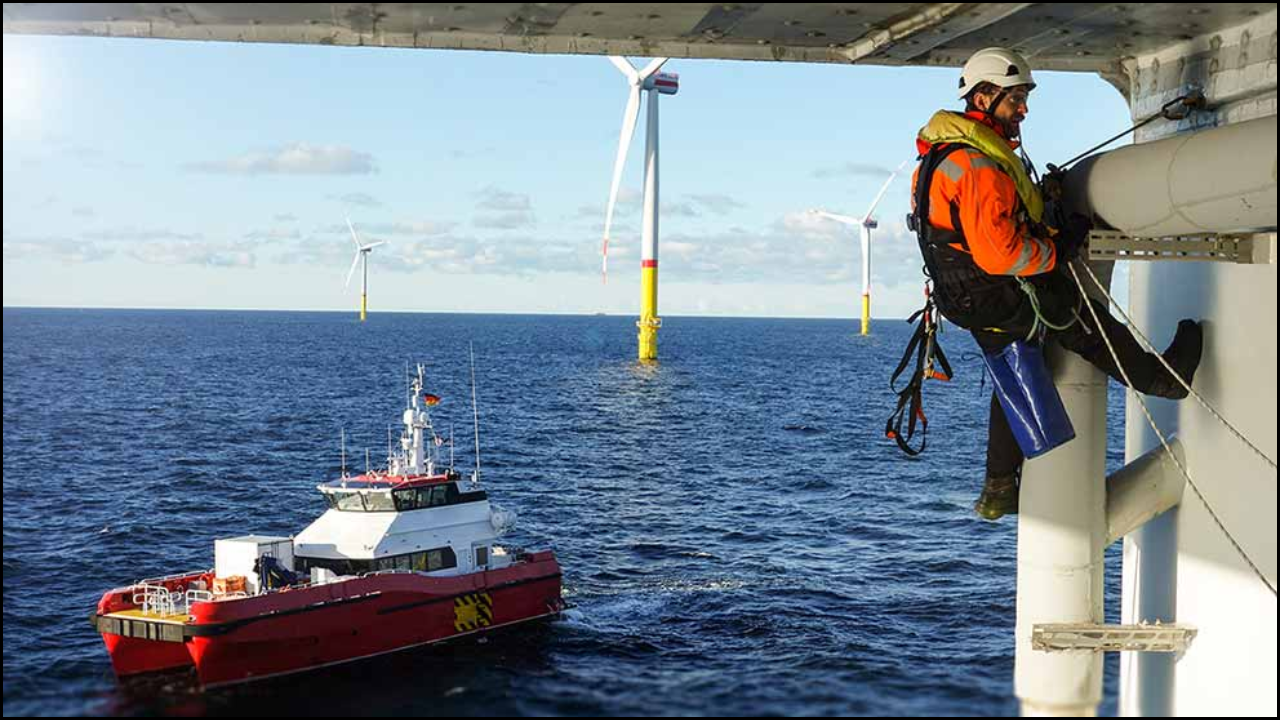
Floating wind turbines mark a transformative shift in the renewable energy sector. Growing energy demands, limited onshore land, and the need for sustainable alternatives have driven innovation beyond traditional fixed-bottom wind farms. Floating wind technology enables turbines to operate in deeper waters, where winds are stronger and more consistent. This innovation is reshaping global energy strategies by unlocking vast marine areas previously inaccessible for clean power generation. The future of floating wind turbines represents not just technological progress but a revolution in how the world captures renewable energy.
Table of Contents
1. Concept of Floating Wind Turbines
Floating wind turbines differ from traditional offshore turbines in their ability to remain stable without being anchored to the seabed through fixed foundations.
- Core Principle: Floating turbines are mounted on buoyant platforms that remain stable through a combination of anchoring systems and mooring lines.
- Flexibility in Location: These turbines can be deployed in waters deeper than 60 meters, far beyond the reach of conventional offshore wind farms.
- Enhanced Wind Capture: Deep-sea environments provide stronger and more consistent winds, leading to higher energy output.
- Design Adaptability: Multiple platform designs—such as semi-submersible, spar-buoy, and tension-leg—allow adaptation to various ocean conditions.
Comparison Between Fixed-Bottom and Floating Turbines
| Feature | Fixed-Bottom Turbines | Floating Turbines |
|---|---|---|
| Foundation Type | Anchored directly to seabed | Buoyant platform with mooring lines |
| Suitable Depth | Up to 60 meters | Up to 1000 meters |
| Installation Flexibility | Limited to shallow waters | Adaptable to deep waters |
| Wind Speed Access | Moderate | Strong and consistent |
| Maintenance | Complex and costly | Easier with modular systems |
2. Technological Design and Structure
Floating turbines integrate advanced marine engineering principles to ensure stability, performance, and longevity under harsh sea conditions.
- Platform Designs
- Spar-Buoy: Uses a long cylindrical structure below the water surface, offering strong stability.
- Semi-Submersible: Supported by multiple buoyant columns, suitable for rough waters.
- Tension-Leg Platform: Anchored by vertical tendons, minimizing vertical movement.
- Anchoring Systems
Flexible mooring lines connect the platform to the seabed, allowing slight movement while maintaining structural integrity. - Dynamic Cables
Cables designed to handle constant motion deliver electricity to onshore grids without damage. - Advanced Materials
Lightweight composites and corrosion-resistant alloys increase durability and reduce maintenance costs.
Major Floating Platform Types
| Platform Type | Key Features | Advantages | Deployment Depth |
|---|---|---|---|
| Spar-Buoy | Deep draft design, high stability | Low motion sensitivity | 100–1000 m |
| Semi-Submersible | Multiple pontoons, balanced structure | Easy installation | 50–800 m |
| Tension-Leg Platform | Vertically tensioned cables | Minimal vertical movement | 200–1000 m |
3. Advantages of Floating Wind Technology
Floating wind turbines present numerous environmental, economic, and technical advantages that make them a leading solution for global clean energy goals.
- Access to Stronger Winds: Deep-sea winds are more powerful and consistent, leading to higher capacity factors.
- Reduced Visual and Noise Impact: Offshore installations are located far from coastlines, minimizing environmental and community disturbance.
- Lower Environmental Footprint: Floating platforms have less seabed disruption compared to fixed-bottom foundations.
- Scalability and Global Reach: Countries with limited shallow coastal areas—like Japan and Norway—can still expand wind capacity.
- Synergy with Other Marine Uses: Coexistence with aquaculture and marine research is feasible, promoting ocean economy integration.
Key Benefits of Floating Wind Turbines
| Category | Benefit | Outcome |
|---|---|---|
| Energy Production | Access to deep-sea wind resources | Increased generation efficiency |
| Environmental | Minimal seabed impact | Ecosystem preservation |
| Social | Reduced visual interference | Greater public acceptance |
| Economic | Broader installation zones | Market expansion potential |
4. Global Developments and Leading Projects
Global collaboration and technological experimentation are driving rapid expansion in floating wind capacity across continents.
- Europe remains a leader, with successful projects like Hywind Scotland and Kincardine Offshore Wind Farm setting benchmarks.
- Asia-Pacific has growing interest, particularly from Japan, South Korea, and Taiwan, focusing on floating installations due to limited shallow waters.
- The United States is exploring projects off the coasts of California and Maine to tap into deep-water wind potential.
- Emerging Nations such as Portugal and Norway are pioneering new pilot farms and exporting expertise.
Major Floating Wind Projects Worldwide
| Project Name | Location | Capacity (MW) | Notable Feature |
|---|---|---|---|
| Hywind Scotland | United Kingdom | 30 | World’s first commercial floating wind farm |
| Kincardine Wind Farm | Scotland | 50 | Largest floating wind project operational |
| WindFloat Atlantic | Portugal | 25 | Innovative semi-submersible platform |
| Goto Floating Wind Farm | Japan | 16.8 | Asia’s first commercial floating installation |
| California Offshore Project | USA | 500 (planned) | Utilizes deep-water floating turbines |
5. Role in Energy Transition and Sustainability
Floating wind turbines are crucial for achieving carbon neutrality and expanding renewable energy portfolios globally.
- Alignment with Net-Zero Goals: Nations are using floating wind to replace fossil fuel generation and meet international climate targets.
- Support for Grid Stability: Consistent wind speeds improve renewable integration into national grids.
- Potential for Hydrogen Production: Offshore turbines can power electrolysis plants to produce green hydrogen at sea.
- Boost to Local Economies: New industries in shipbuilding, steel fabrication, and offshore maintenance emerge around floating projects.
Sustainability Contributions
| Focus Area | Floating Wind Contribution | Impact |
|---|---|---|
| Decarbonisation | Offshore renewable generation | Lower CO₂ emissions |
| Energy Security | Diversified energy sources | Reduced fossil dependence |
| Economic Growth | New marine-based jobs | Regional development |
| Innovation | Research and technological advancement | Sustainable progress |
6. Challenges and Future Prospects
Although floating wind turbines are promising, the technology still faces barriers that must be overcome for large-scale deployment.
- High Initial Investment: Development, anchoring, and transmission costs remain higher than fixed-bottom projects.
- Technical Complexity: Mooring systems, dynamic cables, and platform design require specialized engineering.
- Grid Connection Challenges: Deep-water distances complicate power transmission and infrastructure integration.
- Regulatory and Permitting Issues: International maritime zones often lack clear frameworks for renewable projects.
Challenges and Potential Solutions
| Challenge | Solution | Expected Benefit |
|---|---|---|
| High Costs | Government subsidies and R&D funding | Cost reduction |
| Grid Integration | Development of floating substations | Improved connectivity |
| Design Complexity | AI-driven modelling and simulation | Safer, efficient platforms |
| Policy Barriers | Creation of clear maritime energy laws | Faster project approval |
Final Thoughts
Floating wind turbines stand as a revolutionary development in the clean energy landscape. By extending renewable generation into deep waters, this technology overcomes geographical limitations and enhances global sustainability efforts. Combining advanced engineering, digital innovation, and international collaboration, floating wind energy provides a blueprint for future energy systems. With continued investment and supportive policies, floating wind turbines will play a pivotal role in ensuring a clean, resilient, and renewable-powered world.





